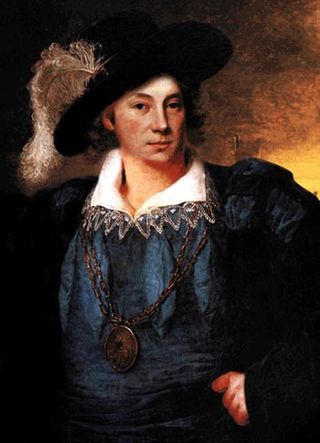Related Research Articles

Jacob Le Maire was a Dutch mariner who circumnavigated the earth in 1615 and 1616. The strait between Tierra del Fuego and Isla de los Estados was named the Le Maire Strait in his honour, though not without controversy. It was Le Maire himself who proposed to the council aboard Eendracht that the new passage should be called by his name and the council unanimously agreed with Le Maire. The author or authors of The Relation took Eendracht captain Willem Schouten's side by proclaiming:

Laurens Cornelis Boudewijn de Graaf was a Dutch pirate, mercenary, and naval officer in the service of the French colony of Saint-Domingue during the late 17th and early 18th century.
This timeline of the history of piracy in the 1620s is a chronological list of key events involving pirates between 1620 and 1629.
Manuel Ribeiro Pardal, also known as Manuel Rivero Pardal or Pardel, was a 17th-century Portuguese privateer in Spanish service during the late 1660s and early 1670s.
Claes Gerritszoon Compaen, also called Claas Compaan or Klaas Kompaan, was a 17th-century Dutch corsair and merchant. Dissatisfied as a privateer for the Dutch Republic, he turned to piracy and captured hundreds of ships operating in Europe, the Mediterranean and West Africa during the 1620s.

Pieter Adriaanszoon Ita was a 17th-century Dutch privateer. He was also an admiral in the Dutch West India Company and, in 1628, commanded a large expedition against Portuguese and Spanish interests in the Caribbean. The expedition was one of the largest of its time and included many of the great privateers of the era.
Sir Michael Geare was a 16th-century English sailor, privateer and merchant. One of the many Sea Dogs who plagued the Spanish Empire during the Elizabethan age, Geare was well known to the Spaniards of the West Indies and the Spanish Main as commander of the Little John. He remained one of the most active in the region throughout the 1590s and up until his retirement in 1603.
Jan Willems, also known as Janke or Yankey Willems, was a 17th-century Dutch buccaneer. Based out of Petit-Goâve, Willems participated in a number of expeditions against the Spanish during the early to mid-1680s with other well-known privateers including Michiel Andrieszoon, Thomas Paine, Laurens de Graaf, Nicholas van Hoorn and Michel de Grammont.
Michiel Andrieszoon was a Dutch buccaneer who served as lieutenant to Captain Laurens de Graaf. He commanded the le Tigre, with a 300-man crew and between 30 and 36 guns. He is occasionally referred to in English as Michel or Mitchell, and is often erroneously given the nickname "Bréha Michiel".

The recapture of Bahia was a Spanish–Portuguese military expedition in 1625 to retake the city of Bahia in Brazil from the forces of the Dutch West India Company (GWC).

The capture of Salvador was a military engagement between Portugal and the Dutch West India Company, that occurred in 1624, and ended in the capture of the Brazilian city of Salvador by the latter. This capture was part of the Groot Desseyn plan of the Dutch West India Company. Although the Dutch intentions were reported to the Spanish no preventive counter-action was taken by them.

Part of the Eighty Years' War, the Capture of Saint Martin was a Spanish naval expedition against the island of Saint Martin, then occupied by the Dutch Republic. The island, claimed by Spain since Christopher Columbus' second voyage to the West Indies in 1493, lies a few hundred miles east of Puerto Rico. Its capture prevented Dutch privateers using it as a base for operations in the Caribbean.

Diego el Mulato is the name given to several pirates who were active in the Caribbean during the 1600s. According to Irene A. Wright, they were all only one person: “Martin (Diego), alias Diego de la Cruz, Diego de los Reyes, Dieguillo, Diego el Mulato, El Mulato, captain Lucifer or Cornieles, mulatto, first helmsman of the Dutch”.
Jean Hamlin was a French pirate active in the Caribbean and off the coast of Africa. He was often associated with St. Thomas's pirate-friendly Governor Adolph Esmit.
Jelles de Lecat was a Dutch pirate and buccaneer who sailed for and against both the English and Spanish. He served with Henry Morgan and was often called "Yellahs," "Yallahs," or “Captain Yellows.”
Peter Lawrence was a Dutch pirate and privateer active off New England and Newfoundland, and in the Caribbean. His and other pirates’ dealings with Rhode Island’s governors nearly led to the colony losing its charter.
Francis Witherborn was an English buccaneer, privateer, and pirate active in the Caribbean. He is best known for his brief association with Henry Morgan.
Thomas Freeman was an English buccaneer and pirate active in the Caribbean. He is best known for attacking the Spanish alongside Henry Morgan, David Marteen, and John Morris.

Juan Corso was a Corsican pirate and guarda costa privateer who sailed in Spanish service, operating out of Cuba.
Peter Johnson was a Dutch pirate active in the Caribbean. He is best known for the circumstances surrounding his trial.
References
- ↑ Smith, Roger C. The Maritime Heritage of the Cayman Islands. Gainesville, Florida: University Press of Florida, 2001. (pg. 59) ISBN 0-8130-1773-4
- ↑ Marley, David F. Historic Cities of the Americas: An Illustrated Encyclopedia. Santa Barbara, California: ABC-CLIO, 2005. (pg. 36-37, 75) ISBN 1-57607-027-1